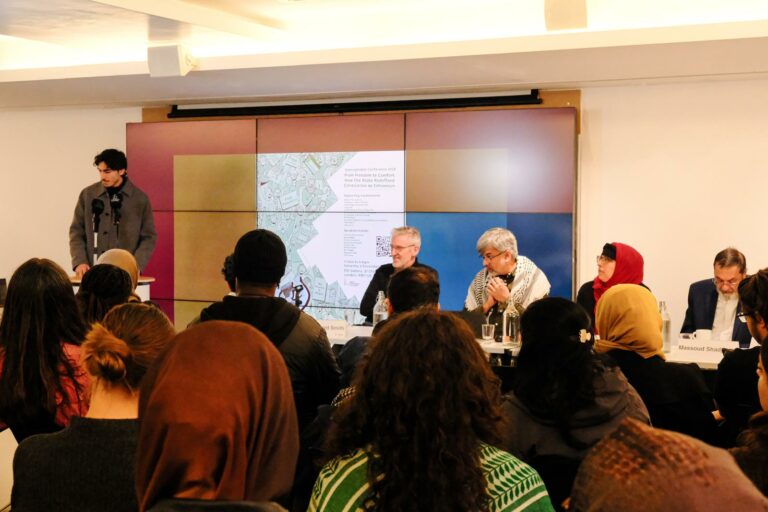Abstract: This article tries to shed some light on America’s attitude towards Palestine vis a vis Israel. Through an analysis of Eurocentrism, Americanism and Zionism, the author finds a disturbingly similar trend in the practice of the Americans towards the Native Indians with the treatment of Palestinians by the Zionists.
No settlement can be just and complete if recognition is not accorded to the right of the Arab refugee to return to the home from which he has been dislodged…It would be an offence against the principles of elemental justice if these innocent victims of the conflict were denied the right to return to their homes while Jewish immigrants flow into Palestine, and indeed, offer the threat of permanent replacement of the Arab refugees who have been rooted in the land for centuries.” –UN Mediator for Palestine, Count Folk Bernadotte, 16 September 1948
The right of return is one of the most fundamental rights granted to displaced persons all over the world and one which is anchored in several bodies of international law. It has historically been shown that the success of peace and security agreements in post-conflict zones is inextricably linked to the right of return of displaced persons and refugees to their homes of origin. A brief examination of the resolution of conflicts in Bosnia, Kosovo, East Timor, and Tajikistan will show the importance of this principle and lend further emphasis to the argument that no Middle East peace agreement will be effective without the practical implementation of the right of return for the Palestinians.
Peace Agreements
The right of return can be found in numerous bodies of international law.[1] Under humanitarian law, a general right of return exists, which applies to all displaced persons, irrespective of how they came to be displaced during the period of conflict. Deliberate, forcible expulsion is expressly prohibited. A military occupant must allow the local population to be permitted to remain in or return to their place of origin following the cessation of hostilities.
The right of return is also a customary norm of international human rights law and can be found in a plethora of international conventions, including the Universal Declaration of Human Rights[2] and the International Covenant on Civil and Political Rights[3], as well as regional human rights treaties. The general prohibition against forcible expulsion is also incorporated into international human rights law.
Finally the right of return is also a very important element of refugee law. The principle of refugees’ absolute right of return to their place of origin (including their homes) is central to the implementation of durable solutions. According to UNHCR Executive Conclusion No. 40, “(a) The basic rights of persons to return voluntarily to the country of origin is reaffirmed and its is urged that international cooperation be aimed at achieving this solution and should be further developed.”[4]
The right of refugees and displaced persons to freely return to their homes of origin is also reaffirmed in United Nations resolutions. This includes resolutions relating to refugee flows from Algeria, Rwanda, Cyprus, Namibia, Cambodia, Afghanistan, Bosnia-Herzegovina, Georgia, Croatia and Kosovo. The huge importance given to this right can be inferred from the descriptions given to it by the resolutions. The right of return has often been described in these resolutions as an unconditional right, as an imprescriptible right, or as an inalienable right. The right of return of refugees and displaced persons is also reaffirmed by UN human rights bodies such as the UN sub-Commission on the Promotion and Protection of Human Rights.[5]
Peace Agreements
The majority of peace agreements that prescribe permanent solutions for refugees and displaced persons recognize their right to return to their homes of origin. These includes agreements in the Balkans, Tajikistan, Georgia, Burundi, Rwanda, Liberia, Sierra Leone, Cambodia, and Guatemala. Significantly, the voluntary character of the return process is stressed. In order to ensure this, agreements state that refugees should be provided with as much information as possible in order to make an informed choice on their future. Agreements also specify that refugees should return under conditions of safety – personal, physical, and material – and dignity.[6]
In the last several decades, almost every major peace agreement to conflicts where there has been mass displacement of refugees has included provisions related to the return of refugees and displaced persons based on international law.[7] This includes the 1989 Agreement on Resettlement of the Population Groups Uprooted by the Conflict in Guatemala, the 1989 Comprehensive Peace Agreement in Cambodia, the 1992 Comprehensive Peace Agreement in Mozambique, and the 1993 Agreement between the Government of Rwanda and the Rwandese Patriotic Front on the Repatriation of Rwandese Refugees. During the 1990s alone, an estimated 12 million refugees were repatriated around the world to countries such as Angola, Bosnia-Herzegovina, Cambodia, Ethiopia, Guatemala, Mozambique, Rwanda and South Africa.
Bosnia Herzegovina
The US-sponsored Dayton Accords is a very good example of a treaty that makes strong provisions for the return of people displaced by armed conflict. Following three years of interethnic civil strife between Serbs, Muslims and Croats, the warring parties initialled a peace agreement on 21 November 1995, in Dayton, Ohio (the final agreement was signed in Paris on 14 December 1995).
The right of almost 2 million Bosnian refugees to return to their properties, or to receive compensation if this was not possible, was enshrined in the peace agreement.
The most significant provision of the Dayton Agreements for the purposes of this discussion is contained in the Annex VII Agreement on Refugees and Displaced Persons.
Article I of this Annex states that
1. All refugees and displaced persons have the right freely to return to their homes of origin. They shall have the right to have restored to them property of which they were deprived in the course of hostilities since 1991 and to be compensated for any property that cannot be restored to them. The early return of refugees and displaced persons is an important objective of the settlement of the conflict in Bosnia and Herzegovina. The Parties confirm that they will accept the return of such persons who have left their territory, including those who have been accorded temporary protection by third countries.
2. The Parties shall ensure that refugees and displaced persons are permitted to return in safety, without risk of harassment, intimidation, persecution, or discrimination, particularly on account of their ethnic origin, religious belief, or political opinion.
Refugee return was seen as an extremely important factor in resolving this brutal conflict.
Tajikistan
In 1997, a UN-sponsored peace agreement[8] was signed in Moscow between forces tied to the old Communist regime and the Islamo-democratic alliance bringing to an end the 5 year civil war in the Central Asian Republic of Tajikistan. The fighting killed tens of thousands of people, displaced some 600,000, and forced a further 300,000 to flee for safety to Afghanistan and Russia.
Under Paragraph 2 of the Protocol on Refugees[9] included to the Agreement, the Tajiki government assumed the obligation to reintegrate returning refugees and internally displaced persons into the social and economic life of the country. Under the agreement, this included restoration of all rights, provision of humanitarian and financial aid, assistance with employment and housing, and return of homes and property. The government also agreed not to undertake criminal proceedings against returnees because of their participation in the political confrontation or war.
The Protocol provided the foundation to increase efforts to ensure the voluntary return of all remaining refugees and displaced persons to their homes within 12 to 18 months from the date of its signature. The Parties called upon the United Nations, the OSCE and UNHCR to provide assistance in order to ensure the safety of returning refugees and displaced persons and to establish and expand their presence at places where such persons were living.
Once again, the parties determined it essential that refugees be accommodated in order that the peace agreement prove successful.
Kosovo
In the late 90s, the Balkans were once again rocked by warfare as hundreds of thousands of Kosovar Albanians fled their homes amidst “ethnic cleansing” by Serbian military and paramilitary groups during the Kosovo crisis. The UN Security Council passed numerous resolutions condemning the ethnic cleansing and reaffirming the right of all refugees and displaced persons to return to their homes. These include resolutions1199[10], 1239[11], and 1244.[12] These guarantees were also implemented in the 1999 Interim Agreement for Peace and Self-Government in Kosovo.[13]
The right of these refugees and internally displaced persons to return to their pre-conflict homes precipitated the North Atlantic Treaty Organization’s (NATO) military intervention in Kosovo. Despite much criticism of the questioned legality of the intervention, the majority of displaced Kosovar Albanians in fact returned to their homes soon after the fighting ceased in early June 1999.
NATO’s message to the Serbs was quite simple; that the bombing would cease once the Serbs stopped driving the Albanian Muslims out of Kosovo. Within days, busloads of refugees, escorted by representatives of the U.N. High Commissioner for Refugees (UNCHR) were heading back to the Kosovo capital of Pristina. Hundreds of thousands of Kosovar refugees have since then returned to towns and villages all over Kosovo.
On 6 May 1999, President Bill Clinton pledged to Bosnian refugees “you will go home again in safety and in freedom.” Four days later then-Secretary of State Madeline Albright vehemently proclaimed, “We must have peace on terms that will allow the people of Kosovo, with our help, to return to their homes and rebuild their communities, and we must have accounting for the wrongs that have been done.”
These statements together with the terms of the Rambouillet agreement and the UN resolutions further evidence the underlying notion that peace and security is unattainable unless the right of return of refugees and displaced persons is both recognised and more importantly implemented.
East Timor
East Timor declared itself independent from Portugal on 28 November 1975 and was invaded and occupied by Indonesian forces nine days later. It was incorporated into Indonesia in July 1976 as the province of East Timor. Following an unsuccessful campaign of pacification for over 20 years, during which an estimated 100,000 to 250,000 individuals lost their lives, the overwhelming majority of the people of East Timor voted for independence from Indonesia in a UN-supervised popular referendum on 30 August 1999.
Between the referendum and the arrival of a multinational peacekeeping force in late September 1999, anti-independence Timorese militias – organized and supported by the Indonesian military – commenced a large-scale, scorched-earth campaign of retribution, killing approximately 1,300 Timorese and forcibly displacing 300,000 people into West Timor as refugees.
Numerous UN Security Council resolutions reaffirmed the right of refugees and displaced persons to return in safety and security to their homes.[14] The success of this peace agreement was in large part due to the repatriation and return of the refugees.
Palestine
Today, the original Palestinian refugees and their descendents are estimated to number more than 6.5 million and constitute the world’s oldest and largest refugee population, making up more than one-fourth of the entire refugee population in the world.
Contrary to all these agreements that address solutions for refugees, the peace agreements between “Israel” and the Palestinians include no references to international law and UN resolutions as the basis for a durable solution for Palestinian refugees.
General Assembly Resolution 194[15] reaffirms the right of Palestinian refugees displaced in 1948 to return to their homes of origin. Paragraph 11(a) states: “refugees wishing to return to their homes … should be permitted to do so.” The General Assembly clearly meant the return of each refugee to “his[her] house or lodging and not to his[her] homeland.” The Assembly rejected two separate amendments that referred in more general terms to the return of refugees to “the areas from which they have come.”[16]
Resolution 194 has been affirmed by the General Assembly of the United Nations nearly every year since it was passed. A total of eight other UN Resolutions have called for implementation of the right of return. Israel’s acceptance into the United Nations in 1949 was explicitly conditioned on its willingness to implement UN Resolution 194. It is interesting to note that to date there has not been a single UN Security Resolution passed regarding the fate of Palestinian refugees even though similar resolutions were passed without question regarding refugees from Bosnia, Kosovo, East Timor and Rwanda among others.
Currently, a primary reason for Palestinians being excluded from norms protecting other refugees is that their issue is being negotiated outside the framework of the United Nations or other bodies charged with upholding international law and human rights standards. The terms of these negotiations are set by the US and Israel (both notorious for violations of international law) and outcomes have actually perpetuated some human rights abuses against Palestinians (such as land confiscation and restrictions on freedom of movement). To date, agreements between Israel and the Palestinians establish procedures and mechanisms to address the Palestinian refugee issue but do not affirm the right of return or the right to freedom of movement. All these agreements state that the issue of refugees displaced in 1948 will be addressed during permanent status negotiations. The very fact that refugee rights, which international law defines as individual, inalienable and non-negotiable, are being subjected to negotiation, illustrates the weakness of the Palestinian position.
For more than five decades, Palestinian refugees have not been able to exercise their legal right to return to their homes inside what is now called “Israel”. There can be no lasting solution to the Israeli-Palestinian conflict that ignores the legitimate rights of the Palestinian refugees. The international community must follow the successful precedent established in the formation of peace agreements in other conflict zones in order to ensure that Palestinian refugees are allowed to exercise their individual right of return.
Abu-Rabi, I. M. (1998) ‘Globalization: A Contemporary Islamic Response?’, in the American Journal of Islamic Social Sciences, vol. 15, No. 3, fall 1998.
Amin, S. (1989) Eurocentrism, USA, Monthly Review Press.
Arvidsson, C. and Blomqvist, L. E. (eds.) (1987) Symbols of Power: The Esthetics of Political Legitimation in the Soviet Union and Eastern Europe, Sweden, Almqvist & Wiksell International Stockholm.
Barbera, H. (1998) The Military Factor in Social Change, New Brunswick and London, Transaction Publisher.
Bauman, Z. (2002) Society under Siege, Cambridge, Polity Press.
Beyer, P. (1994) Religion and Globalization, London, Sage.
Beyer, P. (1998) Globalizing System, Global Culture, Models and Religion(s), in International sociology, March 1998: vol 13(1):79-94, London, Thousand Oaks, CA and New Delhi, SAGE.
Boddy, W. (1998) The Beginnings of American Television, in A. Smith and R. Paterson (eds.) Television: An International History, Oxford, Oxford University Press.
Buckley, A. D.(ed.) (1998) Symbols in Northern Ireland, Belfast, The Institute of Irish Studies, The Queen’s University of Belfast.
Caplow, T. and Hicks, L. (2002) Systems of War and Peace, New York, University Press of America.
Casey, B., Casey, N. Calvert, B. French L. and Lewis, J. (2001) Television Studies: The Key Concepts, London and New York, Routledge.
Castells, M. (1997) The Information Age: Economy, Society and Culture Volume II: The Power of Identity, Great Britain, Blackwell Publishers.
Casto, E. R. (1937) Economic Geography of Palestine, in Economic Geography, Vo. 13, Issue 3 (Jul, 1937), pp. 235-259.
Cohen, M. J. (1976) The British White Paper on Palestine, May 1939, Part II, Testing of a Policy, 1942-1945, in The Historical Journal, Vol. 19, No. 3 (Sep, 1976), pp. 727-757.
Cohen, M. J. (1977) Secret Diplomacy and Rebellion in Palestine, 1936-1939, in International Journal of Middle East Studies, Volume 8, Issue 3 (Jul., 1977), pp. 379-404.
Cohen, M. J. (1979) The Genesis of the Anglo-American Committee on Palestine, November 1945: A Case Study in Assertion of American Hegemony, in The Historical Jouran. Vol. 22, Issue 1 (Mar. 1979), pp. 184-207.
Cvetkouich, A & Kellner, D. (1997) ‘Introduction: Thinking Global and Local’, pp. 1-30 , in A. Cvetkovich & D. Kellner (eds.), Articulating the Global and the Local: Globalization and Cultural Studies, United Kingdom, Westview Press.
Dittmer, L. (1977) Political Culture and Political Symbolism: Toward a Theoretical Synthesis, in World Politics, Vol. 29, Issue 4 (July 1977), pp. 442-583.
Dussel, E. (1998) ‘Beyond Eurocentrism’, in Fredric Jameson and Masao Miyoshi(eds.) The Cultures of Globalization, Durham and London, Duke University Press.
Eisenstadt, S. N. (1995) Power, Trust and Meaning: Essays in Sociological Theory and Analysis, Chicago and London, The University of Chicago Press.
Ghareeb, E., Jennings, P., Koven, R. McCartney, J. and Eggerstrom, L. (1975) The American Media and the Palestine Problem, in Journal of Palestine Studies, Vol. 5, Issue ½ (Autumn, 1975 – Winter, 1976), pp. 127-149.
Giddens, A. (1990) The Consequences of Modernity, Stanfor, Stanford University Press.
Giddense, A. (1994) living in a post-traditional society, in U. Beck, A. Giddense and S. Lash, reflexive modernization: politics, tradition and aesthetics in the modern social order, Cambridge, Polity Press.
Gutfeld, A. (2002) American Exceptionalism: The Effects of Plenty on the American Experience, Brighton and Portland, Sussex Academic Press.
Halperin, S. (1960) Ideology or Philanthropy? The Zionist Fund-Raising, in The Western Political Quarterly, Vol. 13, Issue 4 (Dec., 1960) pp. 950-973.
Hogopian, E. and Zahlan, A. B. (1974) Palestine’s Arab Population: the Demoraphy of the Palestinians, Journal of Palestine Studies, Vo.. 3, Issue 4, pp. 32-74.
Huntington, S. P. (1996) The Clash of Civilizations and the Remaking of World Order, New York, Simon & Schuster.
Huneidi, S. (1998) Was Balfour Policy Reversible? The Colonial Office and Palestine, 1921-3, in Jouranal of Palestine Studies, volume 27, Issue 2 (Winer, 1998), pp. 23-41.
Kinloch, G. C. (1981) Ideology and Contemporary Sociological Theory, New Jersey, Prentice-Hall, Inc.
Klich, I. (1988) Latin America, the United States and the Birth of Israel: The Case of Somoza’s Nicaragua, in Journal of Latin American studies, Vol. 20, Issue 2 (Nov. 1988), 389-432.
Laqueur, W. (1971) Zionism and Its Liberal Critics, 1896-1948, in Journal of Contemporary History, Vol. 6, Issue 4, pp. 161-182.
Lipset, S. M. (1996) American Exceptionalism: A Double-Edged Sword, New York and London, W.W. Norton & Company.
Lockman, Z. (1993) Railway Workers and Relational History: Arabs and Jews in British-Ruled Palestine, in Comparative Studies in Society and History, Vol 35, No. 3 (Jul., 1993, pp. 601-627.
Losurdo, D. (2001) Heidegger and the Ideology of War: Community, Death and the West, New York, Humanity Books.
Lowy, R. F. (1995) ‘Eurocentrism, Ethnic Studies, and the New World Order: Toward a Critical Paradigm’, in Journal of Black Studies, Volume 25: 6, Pp. 712-736.
Madsen, D. (1998) American Exceptionalism, Edinburgh, Edinburgh University Press.
Manual, F. E. (1955) The Palestine Question in Italian Diplomacy, 1917-1920, in the Journal of Modern History, Vol. 27, No. 3. (Sep. 1955), pp. 263-280.
Mazrui, A. A. (1998) ‘Globalization, Islam, and the West: Between Homogenization and Hegemonization’, in the American Journal of Islamic Social Sciences, vol. 15, No. 3, pp. 2-13 fall 1998.
McTague Jr., J. J. (1978) The British Military Administration in Palestine 1917-1920, in Journal of Palestine Studies, Vol. 7, No. 3 (Spring, 1978), pp. 55-76.
Miller III, J. C. (1999) Monopoly Politics, Stanford, Hoover Institution Press.
Ovendale, R. (1974) The Palestine Policy of the British Labour Government 1945-1946, in International Affairs, Vol. 55, No. 3, (July, 1979), pp. 409-431.
Ovendale R. (1980) The Palestine Policy of the British Labour Government 1947: The Decision to Withdraw, in International Affairs, Vol 56, No. 1. (Jan, 1980), pp. 73-93.
Pappe, P. (1997) Post-Zionist Critique on Israel and the Palestinians Part II: The Media, in Journal of Palestine Studies, Vol. 26, Issue 3 (Spring, 1997), pp. 37-43.
Pressler, C. A. and Dasilva, F. B. (1996) Sociology of Interpretation: From Weber to Habermas, New York, State University of New York Press.
Rossi, I. (1983) From the Sociology of Symbols to the Sociology of Signs: Toward a Dialectical Sociology, New York, Columbia University Press.
Said, E. (1976) The Idea of Palestine in the West, in MIRIP Reports, Issue 70 (Sep. 1978), pp. 3-11.
Sayyid, B. S. (1997) A Fundamental Fear: Eurocentrism and the Emergence of Islamis, London & New York, Zed Books Ltd.
Scholch, A. (1992) Britain in Palestine, 1838-1882, in Journal of Palestine Studies, Vol. 22, Issue 1 (Autumn, 1992), pp. 39-56.
Stam, R. (1995) ‘Eurocentrism, Polycentrism, and Multicultural Pedagogy: Film and the Quincentennial’, in R. D. L. Campa, E. A. Kaplan and M. Sprinker (eds.), Late Imperial Culture, London & New York, Verso.
Stein, K. W. (1991) A Historiographic Review of Literature on the Origins of the Arab-Israeli Conflict, in The American Historical
Stone, L. (1997) German Zionists in Palestine Before 1933, in Journal of Contemporary History, Vol. 32, Issue 2 (Apr. 1997), pp. 171-186
Wasburn, P. C. (1982) Political Sociology: Approaches, Concepts Hypotheses, New Jersey, Prentice-Hall Inc.
Weeks, P. (1990) Farewell My Nation: The American Indian and the United States, Arlington Heights, IL.
Wright, Q. (1926) The Palestine Problem, in Political Science Quarterly, Vol. 41, Issue 3 (Sep., 1926), pp. 384-412.
Zureik, E. (1977) Toward a Sociology of the Palestinians, in Journal of Palestine Studies, Vol. 6, Issue 4 (Summer, 1977), pp. 3-16.





